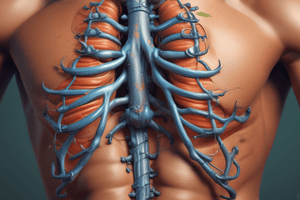Podcast
Questions and Answers
What is the recommended duration for applying each technique during MFR?
What is the recommended duration for applying each technique during MFR?
- 10 minutes
- 3 minutes
- 5 minutes (correct)
- 15 minutes
Which of the following is NOT an indication for MFR?
Which of the following is NOT an indication for MFR?
- Muscle imbalances
- Fascial restrictions
- Restricted joints
- Fractures (correct)
Why should MFR be performed as soon as possible after an injury?
Why should MFR be performed as soon as possible after an injury?
- To enhance blood pressure
- To promote relaxation immediately
- To assist in repair and avoid compensation effects (correct)
- To ensure pain is redirected
What is a key precaution to consider before starting an MFR session?
What is a key precaution to consider before starting an MFR session?
What is the primary technique utilized in Myofascial Release to identify areas of restriction?
What is the primary technique utilized in Myofascial Release to identify areas of restriction?
Which benefit of MFR specifically relates to mental health?
Which benefit of MFR specifically relates to mental health?
Which of the following is a contraindication for Myofascial Release therapy?
Which of the following is a contraindication for Myofascial Release therapy?
Which of the following is a consequence of MFR that necessitates patient precautions?
Which of the following is a consequence of MFR that necessitates patient precautions?
What precaution should be taken when applying Myofascial Release?
What precaution should be taken when applying Myofascial Release?
Which condition would best benefit from MFR therapies?
Which condition would best benefit from MFR therapies?
Which condition is a clear indication for performing Myofascial Release?
Which condition is a clear indication for performing Myofascial Release?
What should be avoided when working on a patient who has experienced an injury?
What should be avoided when working on a patient who has experienced an injury?
What is a key benefit of Myofascial Release?
What is a key benefit of Myofascial Release?
Which condition is a contraindication for myofascial release (MFR)?
Which condition is a contraindication for myofascial release (MFR)?
What is an effect of MFR on scar tissue?
What is an effect of MFR on scar tissue?
What should be avoided during MFR treatment?
What should be avoided during MFR treatment?
Which of the following is an indication for using MFR?
Which of the following is an indication for using MFR?
What does the term 'red flare' indicate during MFR treatment?
What does the term 'red flare' indicate during MFR treatment?
Which of the following is a post-treatment effect of MFR?
Which of the following is a post-treatment effect of MFR?
Which statement about hypertension and MFR is accurate?
Which statement about hypertension and MFR is accurate?
What can MFR help improve after releasing muscular restrictions?
What can MFR help improve after releasing muscular restrictions?
Which precaution is recommended before performing MFR on a scar?
Which precaution is recommended before performing MFR on a scar?
Which condition is NOT a contraindication for MFR?
Which condition is NOT a contraindication for MFR?
What is the primary effect of applying less pressure to tissue during MFR?
What is the primary effect of applying less pressure to tissue during MFR?
How long must MFR techniques typically be performed to influence the fascial network effectively?
How long must MFR techniques typically be performed to influence the fascial network effectively?
Which of the following describes a positive sign for continuing MFR progression?
Which of the following describes a positive sign for continuing MFR progression?
What is the role of bound water in fascial tissue?
What is the role of bound water in fascial tissue?
Which of the following is a rule followed when applying MFR?
Which of the following is a rule followed when applying MFR?
What happens to collagen and elastin fibers during MFR?
What happens to collagen and elastin fibers during MFR?
Which patient sensation indicates effective release during MFR treatment?
Which patient sensation indicates effective release during MFR treatment?
What defines 'end-feel' in MFR therapy?
What defines 'end-feel' in MFR therapy?
What is the primary purpose of MFR techniques?
What is the primary purpose of MFR techniques?
Which texture is important for conducting MFR without slippage?
Which texture is important for conducting MFR without slippage?
Flashcards
MFR Application Timing
MFR Application Timing
MFR should be performed as soon as possible after injury to aid repair and prevent compensations.
Scar Tissue Avoidance
Scar Tissue Avoidance
Avoid working on scar tissue for 6-8 weeks post-injury.
MFR Session Duration
MFR Session Duration
Apply each MFR technique for 5 minutes, then repeat or change.
MFR Patient Consultation
MFR Patient Consultation
Signup and view all the flashcards
MFR and Blood Pressure
MFR and Blood Pressure
Signup and view all the flashcards
MFR and Blood Sugar
MFR and Blood Sugar
Signup and view all the flashcards
MFR Indications
MFR Indications
Signup and view all the flashcards
MFR Benefits
MFR Benefits
Signup and view all the flashcards
MFR Tissue Response
MFR Tissue Response
Signup and view all the flashcards
Fascial Mechanoreceptors
Fascial Mechanoreceptors
Signup and view all the flashcards
End-feel
End-feel
Signup and view all the flashcards
Viscous Ground Substance
Viscous Ground Substance
Signup and view all the flashcards
Collagen Reorganization Time
Collagen Reorganization Time
Signup and view all the flashcards
MFR Treatment Duration
MFR Treatment Duration
Signup and view all the flashcards
Collagen and Elastin Fibers
Collagen and Elastin Fibers
Signup and view all the flashcards
Vasodilation
Vasodilation
Signup and view all the flashcards
Positive Sign of Progression
Positive Sign of Progression
Signup and view all the flashcards
Hydrophilic Tissue
Hydrophilic Tissue
Signup and view all the flashcards
MFR Contraindications (General)
MFR Contraindications (General)
Signup and view all the flashcards
Local MFR Contraindications
Local MFR Contraindications
Signup and view all the flashcards
MFR and Scar Tissue
MFR and Scar Tissue
Signup and view all the flashcards
MFR and Circulation
MFR and Circulation
Signup and view all the flashcards
Post-MFR Effects (pain)
Post-MFR Effects (pain)
Signup and view all the flashcards
Post-MFR Effects (sleep)
Post-MFR Effects (sleep)
Signup and view all the flashcards
Post-MFR Effects (lethargy)
Post-MFR Effects (lethargy)
Signup and view all the flashcards
MFR Effect on Women's Periods
MFR Effect on Women's Periods
Signup and view all the flashcards
MFR Effects on Long-term Pain
MFR Effects on Long-term Pain
Signup and view all the flashcards
MFR: body softening
MFR: body softening
Signup and view all the flashcards
Myofascial Release (MFR)
Myofascial Release (MFR)
Signup and view all the flashcards
Tissue Barrier of Resistance
Tissue Barrier of Resistance
Signup and view all the flashcards
Myofascial Rebounding
Myofascial Rebounding
Signup and view all the flashcards
Viscoelastic Fascia
Viscoelastic Fascia
Signup and view all the flashcards
Mechanoreceptors in Fascia
Mechanoreceptors in Fascia
Signup and view all the flashcards
Study Notes
Myofascial Release
- Myofascial release: Myo means 'muscle', and fascia means 'band'.
- Fascia is a single uninterrupted three-dimensional sheet of tissue covering, surrounding, protecting, and supporting all human body structures.
- It extends from the skull to the soles of the feet, and from the exterior to the interior of the body.
- Fascia is a dynamic, ever-changing, fluid-filled network.
- It's the largest system in the human body.
- Myofascia has 10 times more sensory nerve receptors than muscle tissue.
- It's considered a mechanosensitive system adapting fiber arrangement and density to body demands.
- Fascia includes aponeurosis, ligaments, tendons, joint capsules, certain bone and organ layers, nerves, dura mater, epineurium, bronchial connective tissues, and the mesentery of the abdomen.
- Fascia forms supportive structures maintaining hydrostatic pressure, promoting visceral function, and protecting vital organs.
- Fascia, like muscles, is sensitive to mechanical loads stimulating mechanoreceptors.
- Muscles transmit little force through tendons to bone attachments.
- They distribute their tension across the fascial network to synergistic and antagonistic muscles, nearby joints, and other structures along their lines of tension.
- Fascia is constantly changing, continually morphing in response to internal and external tension.
- The three main elements of fascia are Collagen, Elastin, and Ground substance.
- Collagen is the most abundant protein in the body.
- Elastin is another type of protein.
- Together, collagen and elastin fibers are within a viscous, gel-like fluid called ground substance.
- Fascia's specific composition depends on its function.
- Collagen provides strength and stability to guard against over-extension.
- Elastin provides elasticity, allowing the tissue to stretch to the collagen fiber's limit while absorbing tensile force.
- Ground substance surrounds collagen and elastin fibers acting as a viscous, gel-like fluid composed of hyaluronic acid and proteoglycans.
- It lubricates the fibers, allowing them to glide over each other.
- Ground substance is the environment medium for all body cells.
- The presence of proteoglycans and hyaluronan makes it hydrophilic (water-loving), drawing water into the tissue.
- This provides a cushioning effect and maintains space between collagen fibers.
- The gel absorbs shock and disperses it throughout the body.
- It's a medium for exchanging gases, nutrients, hormones, cellular waste, antibodies, and white blood cells.
- The ground substance's condition affects the rate of diffusion and the health of surrounding cells.
- Fascia is a colloid; it comprises solid material suspended in fluid.
- Colloids are not rigid; they adapt to their containers and respond to pressure.
- The amount of resistance offered by colloids increases with the velocity of applied force.
- Gentle, sustained touch is essential to avoid resistance when releasing fascial restrictions.
- Fascia has variable elasticity, tolerating deformation when forces are exerted, then recovering to its initial state.
- Over time, sustained loading causes creep, slow deformation. Water is forced from tissue, making the ground substance less gel-like.
- Return to the original state is through elastic recoil.
- Time for recoil depends on water uptake and whether elastic potential was exceeded.
- Loading causes tissue lengthening and distortion till equilibrium.
- Sustained loading leads to chronic deformation.
- Injury, trauma, inflammatory processes, and poor posture affect fascia.
- Injury or trauma examples: falling, blows, burns, surgery, medication effects, overuse, or general stress.
- Inflammatory processes involve cellular fluid imbalance, scar formation, and fascial adhesions.
Myofascial Release Procedure
- MFR is a hands-on therapy where a therapist applies pressure to the patient's body.
- It's a three-dimensional, treatment, therapy, and rehabilitation tool.
- The therapist identifies tissue barrier spots to the resistance (feeling tightness, restrictions, and adhesions).
- Approach aspects depend on each other (myofascial rebounding, unwinding).
Myofascial Treatment
- The Myofascial Release Approach has three major components: myofascial release, unwinding, and rebounding.
- Myofascial release is a three-dimensional approach that uses sustained pressure to release restricted fascia.
Myofascial Rebounding
- Myofascial rebounding enhances myofascial release by utilizing fluid/energy dynamics to reduce pain, improve function, and increase awareness.
Myofascial Unwinding
- Myofascial unwinding is a physical movement that comes from a higher intelligence and describes feeling a release.
- The therapist observes spontaneous movements or twitching in the patient's body.
Healing Sequence of MFR
- MFR squeezes out water from fascia, encouraging fresh water return
- Collagen's hydrophilic nature makes water molecules arrange into a liquid crystalline matrix form.
- This matrix boosts the viscoelasticity, promoting bounce and give.
- Mechanoreceptors of fascia react to stimuli.
MFR Mechanisms
- MFR, through kinaesthetic awareness, stimulates mechanoreceptors to release restricted fascia.
- Tissue releases and stretches, stimulating more mechanoreceptors during unwinding.
- Restricted fascia (fibers drawn close) has less bound water and creates tensile forces, impacting pain.
Following Lines of Restriction
- Follow restriction lines back to the origin and remove them; MFR works on a three-dimensional level.
- Therapists note pain, trace restrictions, and release them to balance, restoring function.
- Applications involve slow and sustained pressure at the tissue barrier, and for extended periods without slipping.
- Fascia's viscoelastic nature resists sudden forces.
- Lower pressure yields a greater response; firmer and quicker pressure causes more resistance.
Elements of MFR
- The three elements of MFR work with fascial mechanoreceptors promoting health and function.
- Tissues need 90-120 seconds to rearrange.
- Viscous ground substance controls release ease.
- Collagen reorganizes after 90 to 120 seconds.
- MFR needs more than five minutes to influence the whole fascial network.
- Cross-linkages break down,
- Fascial planes realign.
- Local circulation improves.
- Soft tissue proprioceptive mechanisms reset.
Fascia's Responses
- Fascia softens and yields, allowing for three-dimensional movement following restrictions.
- MFR therapists feel for tissue resistance (end-feel or tissue barrier).
- Positive signs for progression are vasodilatation or red flare, due to increased circulation along pull lines.
Patient Responses
- Patients may feel movement or softening in distant locations from where the therapist touches.
- Collagen is a hydrophilic tissue with water making up most of its composition.
Rules & Principles
- MFR is performed without oils to prevent slippage.
- Patients often wear minimal clothing with towels for drapes.
- Therapists assess the patient pre-treatment (visual, movement, and palpatory).
- Treatment begins at areas that feel tight, hot, or tender.
- Techniques are applied for 5 minutes then repeated.
- Patient forms are obtained.
- MFR should be done promptly after injury to counteract compensation effects.
- Scar sites require avoidance for 6-8 weeks post-injury.
Benefits of MFR
- General health improves due to bound water increase (nutrient and waste exchange).
- Promotes relaxation.
- Eliminates pain.
- Improves joint range of motion and muscle function.
- Improves digestion, absorption, elimination, and posture.
- Facilitates injury recovery and rehabilitation.
Indications of MFR
- Fascial restrictions
- Muscle shortening/imbalance
- Postural asymmetry
- Restricted joints
- Pain from trauma, injuries, or compensation habits.
- Chronic conditions/disorders
- Headaches from the cervical region
- Tight soft tissues
Precautions
- MFR can lower blood pressure, so resting for 15 minutes, horizontally and gradually standing is necessary.
- Blood sugar levels can also lower, prepare with a snack.
- Avoid MFR on open wounds/incisions, instead work on uninvolved areas.
MFR Contraindications
- General: alcohol, active febrile states, infections, contagious colds.
- Circulatory conditions
- Uncontrolled hypertension
- Deep vein thrombosis; aneurysm.
- Swelling/pain (undiagnosed)
- Rapid weight changes
- Breathing difficulties.
- Bowel or bladder issues.
- Specific (local): open wounds, stitches, healing fractures, skin hypersensitivity, infections, osteomyelitis, osteoporosis, rheumatological conditions, severe varicose veins.
Effects on Scar Tissue/Adhesions
- MFR effectively reduces internal scarring and adhesions
- Scar tissue appears softer, and restricted organs/vessels/nerves are released.
- Wait 6-8 weeks before treating scars or areas above/below surgical incisions.
- MFR also aids relaxation, particularly in the post-surgical or postpartum recovery.
Effects on Increased Circulation (Red Flare)
- MFR increases circulation in areas treated, and also adjacent areas along the pull lines.
- Red flares signify areas requiring further MFR.
Post-Treatment Effects
- Therapeutic pain (body stiffness/tenderness).
- Better sleep due to reduced pain and tension.
- Lethargy ("washed out") from release of high tension.
Additional Responses
- Females may experience less painful menstrual cycles.
- Old aches/pains, buried injuries' physical/emotional aspects revealed during release.
- Energy increase from releasing tension.
- Physical/emotional responses include breathing changes, skin color shifts, perspiration, trembling/vibration, movement, and emotional release.
Studying That Suits You
Use AI to generate personalized quizzes and flashcards to suit your learning preferences.




